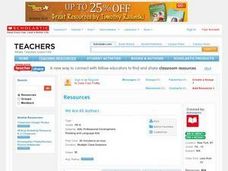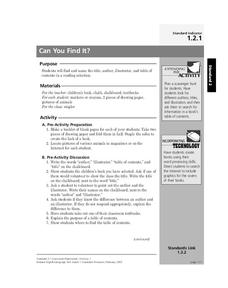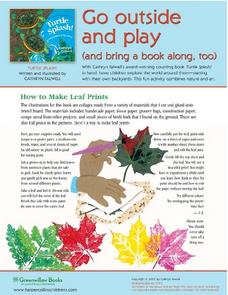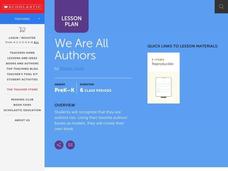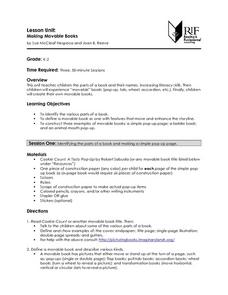Curated OER
We Are All Authors: Create a Book
Every child is an author with this engaging reading activity. First the class reviews the various parts of a book such as the title, author, dedication, and author-biography. Then each individual will choose a story of their own to...
Curated OER
My Community Book
Young learners examine different places in their neighborhood using informational texts. First they identify a place that they like to play and predict if it will be in the nonfiction book Community at Play.They will share their favorite...
Curated OER
Introduce: Cause and Effect
Introduce beginning readers to cause and effect in a story by exploring it together. Learners make predictions about a book based on its cover, title, and a brief flip through the pages. They listen to an explanation of cause and effect...
Curated OER
Nonfiction Books: Table of Contents and Index
How do you find what you're looking for when reading a nonfiction book? Even first graders can learn how to use a table of contents and an index. They use the provided images of each to locate information and answer nine questions.
Curated OER
Text Features of Fiction, Poetry, Drama: Story Matrix
How do novels differ from plays? Explore with your class the text features of fiction and drama by reading The Hidden One: Native American Legend and then performing a reader’s theater script based on the story. Class members create a...
Curated OER
Can You Find It?
Plan a Parts of a Book scavenger hunt. Begin by giving your young adventurers a book, and asking them to find the title, author, illustrator, and table of contents. After a discussion of the purpose of each of these items, class members...
Curated OER
Non-Fiction Text Features
Distinguish between textual features of non-fiction in the book The Lewis and Clark Expedition and in the non-fiction story "Ta-Na-e-Ka." Third graders create posters and participate in group discussions to show their understanding of...
Curated OER
Identifying Text Features of a Self-Written Fable
Make learning the parts of a book fun by having pupils construct their own glossary entries, table of contents, and title page. Beginning with a review of text features and a hunt for examples, kids use previously written fables to...
Curated OER
Cathryn Falwell Books
Learn more about making texture prints with a variety of objects. Young illustrators are introduced to Turtle Splash! and Scoot! in order to examine the collage illustrations. They create their own illustrations by making paint prints of...
Curated OER
We Are All Authors
Read and discuss a variety of books by different authors and have your class create their own book. They will identify the different parts of a book, then using a story they have already written, they enter their story and information...
Curated OER
Making Movable Books
Investigate the parts of a book and in particular, the pop-up, tab, wheel, and or accordion features that can be added to a book to move and enhance the storyline. This is a three lesson unit.
Curated OER
Review Parts of a Book
Begin the year with a review of the parts of a book. Exercises in the unit plan ask emergent readers to identify the information on the cover of a book and on the title page, to explain the purpose of a table of contents, and to describe...
Curated OER
Contents Page 1 (Table of Contents)
After inspecting the illustrated sample of a Table of Contents provided on a one-page worksheet, primary readers write their responses to five questions based on the model.
Curated OER
Parts of a Book Crossword Puzzle
A Parts of a Book worksheet asks emergent readers to complete an eight-question crossword puzzle using the words provided in a word bank. The definitions of the key terms are the vertical and horizontal clues. An answer key is provided.
Curated OER
School - Home Links: Parts of a Book
Parents or learning partners assist emergent readers with a School-Home Links worksheet. The children complete a matching activity about the parts of a book which include a table of contents, title page, and glossary. They match the word...
Curated OER
School-Home Links
Engage parents in their child’s learning process with a School-Home Links worksheet. The one-page resource offers a definition and an example of a book with chapters. With the guidance of their parent or learning partner, the child...
Curated OER
Identifying Features of Nonfiction Text
Learners explore nonfiction text. They identify the cover, title page, and table of contents of a nonfiction book. Pupils work in groups to create a chapter for a nonfiction class book about heroes.
Curated OER
Insects
It's a fact: kids love bugs! With this lesson, young learners explore reading informational texts and conducting research while learning about their favorite insects. Spark learners' interest by reading a book about one kind of bug and...
Curated OER
Let's Learn Library Language
This PowerPoint presentation provides a review of 'library language', vocabulary associated with books and the library such as cover, title, author, illustrator, call number and fiction/nonfiction. Each slide of this PowerPoint displays...
Curated OER
Nadia's Hands
Students locate the parts of a book and respond to a read aloud of that book. In this literacy lesson, students participate in an interactive read aloud of Nadia's Hands in which they locate the cover and title of the book. They discuss...
Curated OER
A Book's Title Page
In this title page worksheet, students read information about the title page and copy the titles and authors from books on the blank title pages on the worksheet. Students copy two titles and authors.
Curated OER
Cover To Cover
Young learners are introduced to the most basic elements and concepts of a book with this pre-kindergarten language arts lesson plan. Through modeling and discussion, the whole class explores how to read a book and how to determine if...
Curated OER
Parts of a Book
Second graders learn to identify the parts of a book. In this book parts instructional activity, 2nd graders learn the names of book parts by participating in a teacher led instructional activity in which they look at transparencies....


